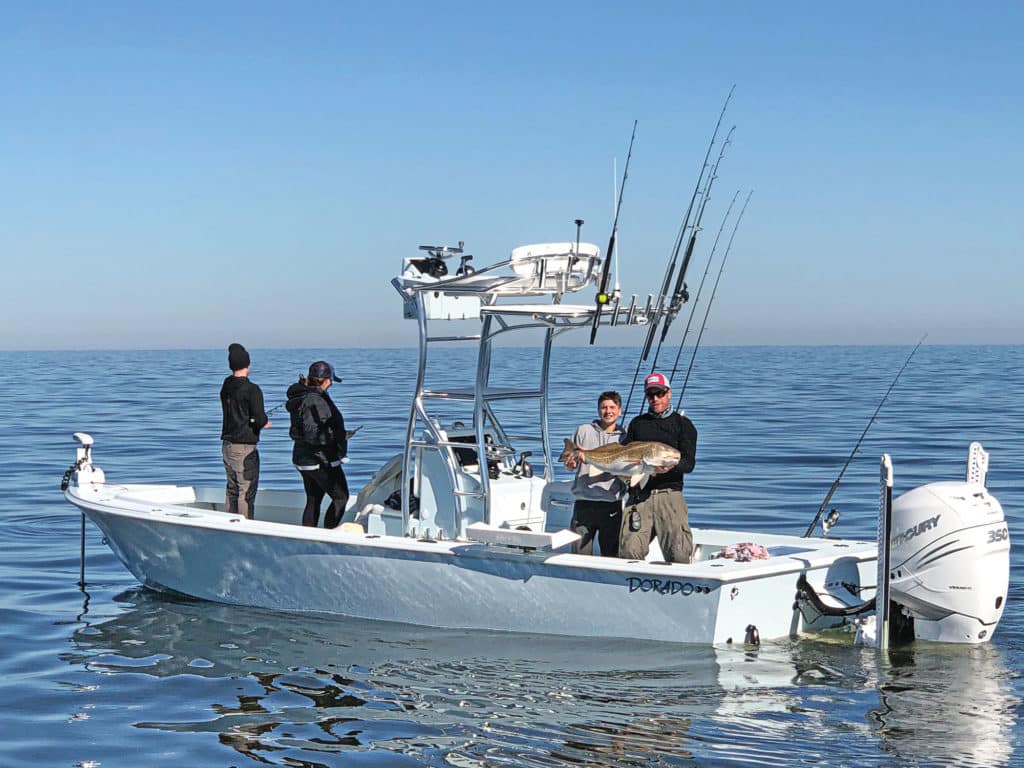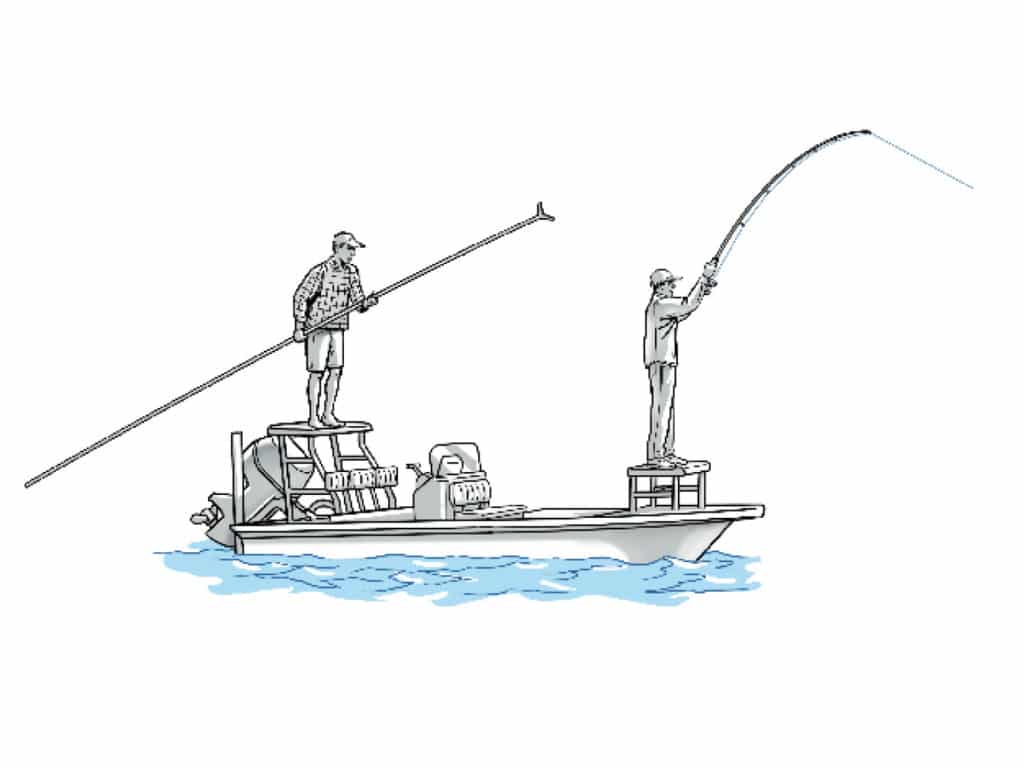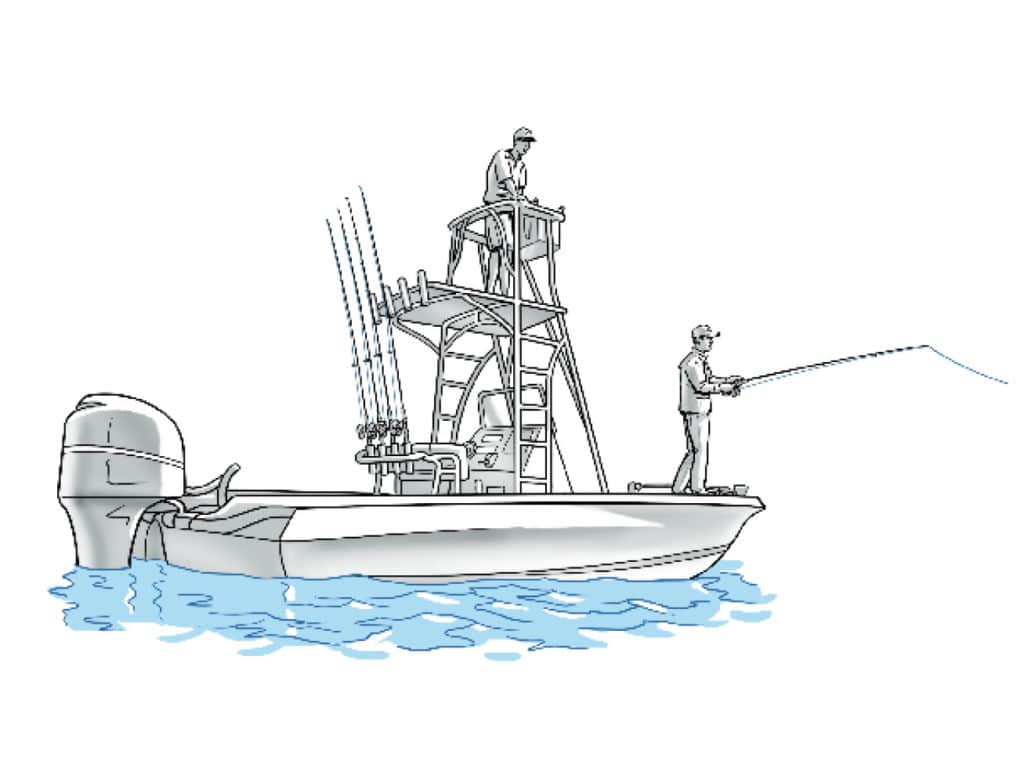
There are several requirements for successful fish spotting. Quality polarized sunglasses are crucial, bright sunlight plays a huge role, and calm seas certainly are a big help. An elevated vantage point also yields big benefits. It changes one’s angle of vision and reduces glare reflecting off the water, making it easier to detect movement and shapes below the surface, which is why spotting towers, and poling and casting platforms are considered must-have tools by those who bank on their eyes to locate their quarry.
Capt. Rob Aldridge of Southeastern Angling uses all three accessories on his Dorado 25 center-console and Hell’s Bay Waterman 16 skiff when guiding clients in coastal Georgia, north Florida and the Florida Keys.
“A good deal of my fishing is in open water, with a lot of looking. So I went with the highest half-tower Dorado builds for my boat,” Aldridge explains. “The base is above the console, 5 feet, 2 inches off the deck, and far enough forward that I don’t have obstructions when spotting fish. I had it rigged with full controls and electronics. Come tarpon season, I spend my days up there.
“Obviously, higher is better for spotting, but if the tower is too tall for the boat’s size, it becomes top-heavy. I also needed it low enough to clear when I hoist my boat up in the slip. But the half-tower offers a tremendous advantage, even in overcast conditions. It is definitely a game changer. From a distance, I’m able to see things I wouldn’t otherwise, like rays with 20 cobia swimming with them, or a school of bull reds floating just below the surface.”
For his inshore trips, Aldridge uses a Hell’s Bay poling skiff with a factory-issue poling platform on the stern, and a Blue Point casting platform on the bow. The poling platform gives him a better angle to propel the skiff -silently with the push pole, but the added height also lets him see farther ahead of the boat, over the head of the angler on the bow.
Sized Right
The angler atop the casting platform, meanwhile, benefits from the added height to pinpoint the fish and present the lure or fly before it spooks. Plus, the elevation also boosts casting distance. “The Blue Point casting platform is 14½ inches high in a wedge pattern,” Aldridge explains. “The top is covered in SeaDek for cushion and less noise.”

Aldridge prefers a smaller casting platform so the angler doesn’t risk falling or causes unnecessary movement when walking around it. Twin receiver tubes with a locking pin are welded underneath the platform’s top to accept a vertical leaning brace, often derisively called a “sissy bar,” which can be mounted forward or aft for support and more stability in bumpy conditions.
Capt. Steve Hobbs took his casting platform to new heights, literally. The St. Marks, Florida, guide had a local welding shop fabricate a custom version for the bow of his Skeeter 23 bay boat. Constructed of 1½-inch aluminum tubing, with an aluminum diamond-plate base, the folding platform is 4 feet, 2 inches to the stand, with a removable, rectangular waist tube for safety, and rod holders welded to the aft legs. The entire structure is powder-coated to match the boat finish.
“My friends bust my chops, saying I put my deer stand on the boat, but it works well,” Hobbs says. “Once someone climbs up, they don’t want to leave. Two anglers feel secure up there, and they see fish 10 times better. Plus, the height provides a better angle for working topwaters, so the lures dance more.”

Hobbs also enjoys solo fishing from his new perch, which is secured with deck mounts and ratchet straps. Using remote controls for his trolling motor and Power-Pole anchor, he’s able to maneuver the larger craft among the many shallow rock piles strewn about the Forgotten Coast while hunting for redfish and trout. Twin rod holders on the platform hold additional outfits rigged with alternate baits.
Take into account the boat’s length and beam when adding a tower, to ensure proper balance and offset the pendulum effect. Base mounts should be through-bolted whenever possible, with backing plates for structural integrity. Nonskid marine matting and bolsters are add-ons worth considering.
Read Next: Advantages of Elevated Electronics Helm Station
Before adding a tower, or a poling or casting platform, to your boat, also check your clearance requirements. Measure boat-lift and garage-door heights, and calculate the minimum clearance (at high tide) of any fixed bridges over the waterways you often navigate. And remember that a poling platform should be tall enough for the outboard cowling to clear when raising the motor.









